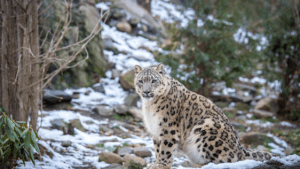TAG: GS 3: ECOLOGY AND ENVIRONMENT
THE CONTEXT: In a groundbreaking effort, India has conducted its first-ever comprehensive survey to estimate the population of snow leopards, unveiling a count of 718 individuals in the wild.
EXPLANATION:
- The elusive nature of these cats, coupled with their habitat in hard-to-access mountainous terrain, has made this four-year-long estimation exercise a significant milestone in understanding and conserving the endangered species.
Distribution Across Regions: Ladakh Dominates, followed by Northern States
- The survey delineates the distribution of snow leopards across various regions in India.
- Ladakh emerges as a stronghold with an estimated 477 individuals, followed by Uttarakhand (124), Himachal Pradesh (51), Arunachal Pradesh (36), Sikkim (21), and Jammu and Kashmir (9).
- This geographic insight provides valuable data for targeted conservation efforts and highlights the critical role of specific regions in snow leopard preservation.
Global Significance: India’s Contribution to Snow Leopard Conservation
- The estimated 718 snow leopards in India constitute approximately 10-15% of the global population.
- This revelation underscores India’s significance in the global conservation landscape and emphasizes the need for collaborative efforts to ensure the survival of this vulnerable species.
Survey Methodology: Camera Traps and Extensive Trail Surveys
- The survey employed an innovative approach involving the strategic placement of ‘camera traps’ in 1,971 locations.
- Additionally, teams covered 13,450 km of trails, meticulously documenting signs of snow leopards, such as scat, hair, and other distinctive markers.
- This methodology mirrors established techniques used in tiger surveys, providing a scientific basis for estimating elusive wildlife populations.
Snow Leopard Population Assessment in India (SPAI): A Collaborative Initiative
- Initiated in 2019, the Snow Leopard Population Assessment in India (SPAI) involved collaborative efforts between the Wildlife Institute of India, the Worldwide Fund for Nature-India, and the Nature Conservation Foundation, Mysuru.
- This synergy between governmental and non-governmental entities showcases the collective dedication to understanding and safeguarding the snow leopard population.
- The snow leopard’s population assessments have evolved over the years, transitioning from limited research in the 1980s to the recent SPAI survey covering approximately 80% of the species’ range.
- This progress signifies an increased understanding of the species, providing crucial information for targeted conservation initiatives.
Conservation Challenges: Human-Wildlife Conflict, Poaching, and Free-Ranging Dogs
- Despite being classified as ‘vulnerable’ by the International Union for the Conservation of Nature, the snow leopard faces an array of threats.
- Human-wildlife conflicts, poaching, and interactions with free-ranging dogs pose significant challenges to the species.
- Unlike tigers, poaching is not the primary concern for snow leopards, with conservation efforts driven by increased sightings and a global interest in species preservation.
Future Prospects: Building on a Scientific Baseline for Conservation
- As India unveils its snow leopard census results, the focus shifts to future conservation endeavors.
- The established baseline from this survey will serve as a reference point for future assessments, guiding conservation strategies, and fostering international collaboration for the protection of this majestic species.
Snow leopard:
- It is found in the mountainous regions of central and southern Asia.
- In India, it is seen in Jammu and Kashmir, Himachal Pradesh, Uttarakhand and Sikkim and Arunachal Pradesh.
- The Hemis National Park has a good presence of Snow Leopard.
- They play a key role as a top predator, an indicator of the health of their high-altitude habitat, and, increasingly, an important indicator of the impacts of climate change on mountain environments.
- Solo traveller: the snow leopard is usually solitary and highly elusive
- Crepuscular: dawn and dusk are the cat’s most active times
- Living large: some snow leopards have home ranges of up to 1,000 square kilometers
- Single moms: for about 18 months, females raise their cubs – all alone
- Cold and dry: the snow leopard primarily lives in arid, barren mountain areas
- Gentle: snow leopards are not known to be aggressive toward humans
- Carnivorous: the cat’s main prey are ibex, argali and blue sheep
- Conservation status:
- IUCN Red List: Vulnerable
- Under CITES it is listed in Appendix I
- Wildlife (Protection) Act 1972: Schedule I

Conclusion: A Pioneering Step in Snow Leopard Conservation
- The culmination of India’s first snow leopard survey marks a pioneering step in wildlife conservation.
- With robust methodology, collaborative efforts, and technological advancements, this endeavor sets the stage for informed conservation actions.
- It ensures a sustainable future for the enigmatic and endangered snow leopards in India and beyond.

